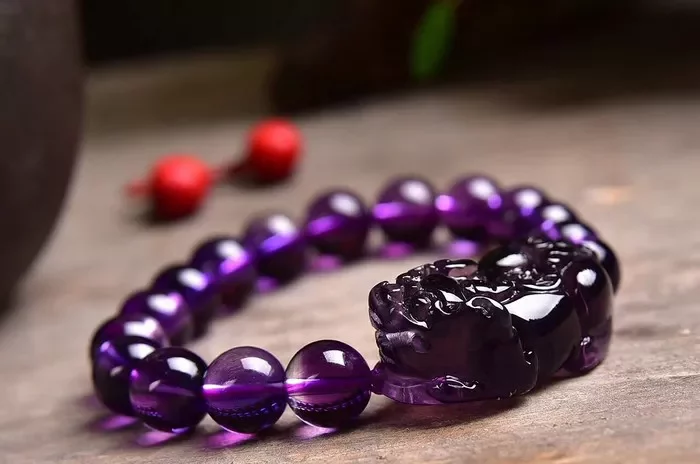Amethyst necklaces, adorned with the gemstone known for its deep purple hues, have been captivating individuals for centuries. This semiprecious stone, with its roots deeply embedded in ancient mythology and folklore, carries a multitude of meanings and associations. One of the most enduring beliefs surrounding amethyst is that it brings good luck. This article aims to provide a comprehensive exploration of this belief, delving into the origins, properties, and cultural significance of amethyst, and examining whether it truly symbolizes good luck.
Origins and Legends of Amethyst
The name “amethyst” is derived from the Greek word “amethystos,” which translates to “not drunken.” This etymology stems from a Greek myth that tells the tale of a young maiden who, in an attempt to escape the unwanted advances of the wine god Dionysus, invoked the aid of the moon goddess. As a result, she was transformed into a crystal-clear quartz, preserving her virginity. Dionysus, heartbroken and in despair, poured his wine over the quartz, turning it into a deep purple stone. Hence, the Greeks named it “amethystos,” believing that the gemstone possessed the power to prevent drunkenness.
This mythological tale encapsulates the ancient fascination with amethyst and its perceived mystical properties. Over time, the stone’s reputation grew, and it became associated with a variety of benefits and meanings, including protection, wisdom, and spiritual clarity. Its connection to Dionysus and the act of pouring wine over it also linked it to the idea of purification and transformation.
Chemical Composition and Properties
Amethyst is a variety of quartz, which is a common mineral composed of silicon dioxide (SiO2). Quartz is one of the most abundant minerals on Earth, found in various colors and forms. What sets amethyst apart is its distinct purple hue, caused by trace amounts of iron and manganese impurities within the crystalline structure. These impurities absorb certain wavelengths of light, reflecting back the purple shades that we see.
The hardness of amethyst, which is around 7 on the Mohs scale, makes it suitable for jewelry-making. It can withstand scratches and daily wear, though it should still be handled with care to avoid sudden impacts that could crack or chip the stone. Amethyst’s clarity and vibrant color make it an ideal choice for necklaces, where its beauty can be fully appreciated.
Cultural Significance and Symbolism
Throughout history, amethyst has been revered across various cultures for its unique properties and associations. In ancient Greece and Rome, it was worn as a protective talisman against drunkenness and evil spirits. Its deep purple color was also believed to symbolize royalty and power, leading to its use in royal jewelry and regal attire.
In the Middle Ages, amethyst was thought to possess healing properties, with beliefs that it could alleviate pain, aid sleep, and improve mental clarity. During this time, it was often worn as an amulet to guard against poisoning and disease. Its association with purification and spirituality made it a popular choice for religious artifacts and decorative items.
Symbolism of Good Luck
The belief that amethyst brings good luck is deeply rooted in its historical and cultural significance. Its protective qualities and associations with purity and transformation naturally lend themselves to the idea of good fortune. In many cultures, amulets and talismans made of precious and semiprecious stones were believed to have magical powers that could ward off evil spirits, bring prosperity, and ensure a smooth journey through life.
Amethyst’s connection to Dionysus and the act of purification through wine also ties it to the idea of renewal and new beginnings. In this sense, wearing an amethyst necklace could be seen as a way to invoke these positive energies, attracting good luck and favorable outcomes.
Furthermore, the stone’s calming and soothing effects on the mind and emotions can also be interpreted as a form of good luck. By promoting mental clarity, reducing stress, and enhancing inner peace, amethyst can help individuals make better decisions, navigate life’s challenges more gracefully, and attract positive opportunities.
Modern Interpretations and Uses
In contemporary society, the symbolism of amethyst has evolved, but its association with good luck persists. Many people still believe in the protective and healing properties of the stone, wearing it as a charm against negative energy and to attract positive vibes.
In the realm of jewelry, amethyst necklaces are a popular choice for their elegance and versatility. They can be worn for both casual and formal occasions, pairing beautifully with a range of outfits. The stone’s deep purple hue is particularly striking when set against the skin, adding a touch of sophistication and mystery to any ensemble.
Many jewelers also incorporate amethyst into designs that symbolize love, commitment, and relationship milestones. Engagement rings and wedding bands featuring amethyst accents are becoming increasingly popular, as the stone’s meaning of purification and transformation aligns with the idea of a new beginning in a partnership.
Despite its modern interpretations, the ancient beliefs surrounding amethyst continue to influence its use and symbolism. Many individuals still wear amethyst necklaces as a way to connect with their past, honor their cultural heritage, and seek protection and guidance in their lives.
Conclusion
The belief that amethyst necklaces bring good luck is a multifaceted one, rooted in the stone’s historical, cultural, and mystical associations. From its ancient Greek mythology to its modern uses in jewelry and healing practices, amethyst has been a symbol of purity, protection, transformation, and good fortune. While there is no scientific evidence to support the idea that amethyst itself possesses magical powers, its ability to evoke positive emotions, promote mental clarity, and inspire inner peace can certainly be seen as a form of good luck in one’s life.
- How Does Amethyst Get Its Color?
- Amethyst and Calcite: A Rare and Beautiful Combination
- Amethyst and White Quartz: Unraveling the Secret Behind the Color…


